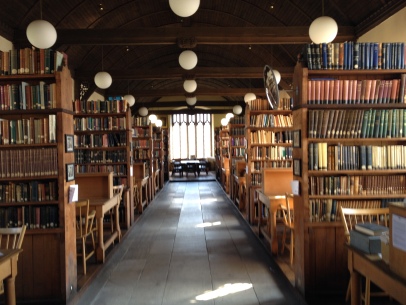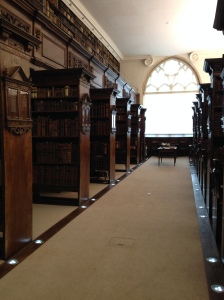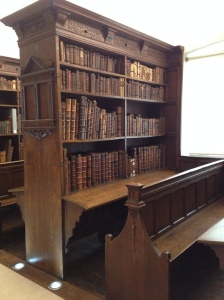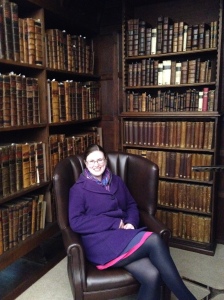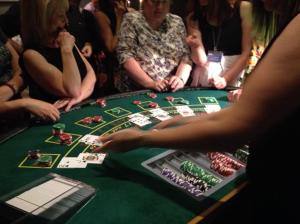A course I really want to do – actually in Newcastle! (1/4/14)
This all started quite a while ago when the CILIP RBSCG tweeted “Where should we run training outside of London?” and I immediately said “NEWCASTLE!” and offered them a barter – free room for free place? It all took a while to organise, but eventually today it all came together beautifully. The course was not just full, it was over subscribed so we stretched it to include another two places and it was everything I needed it to cover.
Instead of all of us going down to London, Hugh Cahill came up from Lambeth Palace Library and Iris O’Brien trekked up from the British Library to give us the high speed, idiot’s guide to DCRM(B). It was designed for cataloguers who use AACR2/MARC already but want to know how to expand their rare books records to be more informative and useful for their users. Helpfully, for those of us on a low budget (aren’t we all?) DCRM(B) is available free on this website which is a great start – actually being able to access to rules (unlike the RDA Toolkit – far, far out of my budgetary range but that’s a whole separate discussion).
We started with the Objectives and Principles which I hadn’t ever really properly read, I realised. I had always leapt straight into DCRM(B) with a specific question of “how do I record this awkward element of X early book” rather than looking at the rules as a whole and understanding the ideas behind it. So I highly recommend reading through those and actually thinking about the end user that you are cataloguing for rather than just cataloguing it for other cataloguers.
Next up was transcription issues (punctuation, 23 letter alphabet and nasty abbreviations). I feel I need to check my ISBD punctuation crib sheet and ensure that I have all of those correct too. Luckily, not many of my books are early enough to have the 23 letter alphabet but apparently there’s a helpful conversion table in the rules for those of us who don’t meet it very often. Again and again came the need to provide multiple versions of the title in 246 to help users find it without knowing the exact title of the copy in your hand.
So into the 245 field: main lessons were
- all from the title page
- No abbreviations
- Can’t omit any of the first 5 words (really, would you want to??)
- ALL contributors/authors (no rule of three – also gone in RDA which I feel is a good thing)
- Do not omit titles of nobility (oops…)
- Don’t add accents which aren’t in the original (even if they would be there in modern French)
- If the SoR is grammatically linked to the title (i.e. in genitive case) then you can’t move it.
- If the author is given elsewhere in the book, don’t put in 245c but DO make a 100/700 access point and a note.
Area 2: Edition (250)
Transcribe EVERYTHING and avoid abbreviations. Even if it takes several sentences. And an impression may equate to an edition for handpress books so you might need to include that here too.
Area 4: Publication (260)
Full transcription again. Prefixes, phrases, addresses, sold by. The lot. “Printed at the x for the y near z”. Multiple 260a’s for all those extra place names but try and maintain the order on the page. That’s MUCH more than I was previously putting so this was probably the steepest learning curve. Particularly when they added that we should have the whole date in 260c including the days and months if they give it on the original and any “in the year of” or “anno” text as well.
Added Entries (700)
This was probably my biggest shock/change/sinking feeling moment – you need a 700 (ideally!) for everyone involved in the creation of the book. The publisher. The bookbinder. The bookseller. Eep! That’s a lot of extra authority records for our system and a lot of extra added entries. I can see why; it’s a neat idea for someone tracking everything published/sold/bound by a particular person but it’s just a whole new thing for me to do which I have somehow completely missed.
Formats, Signatures and Cancels
Then after the big shock, came the maths and the practical exercise. Now maths is not my strong point. Not even basic arithmetic to be honest so this was tricky. It was all to do with understanding how the book was put together from folded sheets of big paper. From hearing the explanation I now know that I would have made a lousy printer as I would have definitely got confused and got my text upside down at least once in every form. Utterly impossible and I now have a lot more sympathy with printer’s errors.
We folded a sheet to understand how you get folio, quarto and octavo then we looked at signatures. No, not the sort you do with a pen to write your name (I thought we had skipped quickly on to provenance at first…) but the little letters at the bottom of a page. A1, A2, B2 – that kind of thing. They’re to help the bookbinder get the pages in the right order when they put all the gathers (folded bits of paper) together and we can describe it on a catalogue record. I would explain further but I haven’t found superscript on here yet which would make it difficult and I’m not sure I’m the best person to describe it. Try Gaskell instead if you need to know. Needless to say this is where the maths came in (turns out I can’t multiple 8 by 7…) but I did understand the underlying principles. And in the handouts there was a handy chart to check whether the number you think you should have according to the signature matched the number given by the page numbers. Hurrah, someone else did the maths!
Cancels are new corrected leaves inserted because there was an error. Look for the stub where the original page was cut out, added hints could be if the page didn’t line up or was different paper with the chain lines going the other way.
Describing
The physical description should include all leaves including unnumbered sequences. Also keep that end user in mind; people are often more interested in the provenance, annotations, bindings, stamps and shelf marks than they are in the actual main body of text. After all, they probably got that online already…
300a: Transcribe the page numbering. Even lower case or capital roman numerals should match the original. Add “28 plates (1 folded)” type phrases for illustrative plates.
300b: What’s an illustration? A major picture. Not a printers device. Can also say what the production process of the illustration was (e.g. woodcut) if you know.
300c: height in cm plus (fol.) (4to) (8vo) in brackets afterwards to record the format.
We covered format earlier in the session although I will admit to still not feeling entirely confident with describing that one. Perhaps with a little more practise and the helpfully provided cribsheet. Also, it’s not something which has featured in any of our existing catalogue records so I’m not sure I should start including it. How useful can it really be to a user? After all, they know the height of the item so it doesn’t tell them anything extra there. I think I need to be more convinced of it’s usefulness, particularly as it would take me a great deal of time.
Adverts: include the pages of adverts in your 300a if they are integral to the publication, so if they’re the same pagination (fairly obvious and I would have automatically included them in that case anyway personally) or in the same gathering as text or the same signature sequence. I also add a 650 in house subject heading of “advertisements” thanks to the number of enquiries I have had relating to adverts for things. It’s quicker in the long run, believe me!
Volumes: Bibliographic vs Physical. You’re recording how the publisher issued it, not how some Victorian binder thought it should be later on. So hence you get “3 vols in 5” where they have been split or “8 vols in 4” where they have been merged.
Notes
All the way through the day, both Hugh and Iris said, “and you would add a note about that” and this is where we came to the 500s and all those notes. So in a whistlestop tour of the 500s we had:
- Signatures. Note if considered important – and always for incunables – particularly if your sequence doesn’t match those in the published bibliographies.
- References (510) – put them in if you have used other sources to provide your info.
- Subject headings. Important if the keyword search is limited by archaic terminology and non-standardized spellings.
- Provenance (561) – give names, what evidence, location in the volume, date (if ascertainable) and relation to the book. Add 700 headings for any of the people mentioned giving their relationship in 700e and remembering to put in your local library code to show it’s copy specific. Things like “armorial bookplate of William Marsden on pastedown”. or “bequest of Mr Smith (booklabel)”. All very helpful if (God-forbid) one of your books gets stolen and you have to prove that it’s that specific copy now on sale down the road…. Good message for senior management: “Good cataloguing is good security”
- Binding (563) – materials, decoration, fittings, end papers and pastedowns, headbands, date, place, binder’s name, references, repairs. Quite a long list and don’t forget your local library code again.
- Other copy specific info (562). Imperfections/misbindings. Variants. Interleaving. Hand colouring and Bound with (Such as “bound with 17 others, first item is X and spine reads Y”.
DCRM(B) and RDA
The first (very positive) thing Iris had to say about RDA is, you don’t have to do it! DCRM(B) is a valid standard in it’s own right. Equally she recognised that many people will be working within institutions which are moving towards RDA and they are working towards DCRM2 which would be a consolidated set of rules (for maps, serials etc as well as books) that would fit in with RDA. A big job obviously and also hampered by licensing complications as they would like to provide it free online however that’s tricky with copyrighted RDA text.
DCRM(B) only covers the descriptive elements of a catalogue record so you can still happily use RDA access points without calling it a hybrid record. You can also make hybrid records and there’s some helpful guidance about that here called the BIBCO standard record. It gives the RDA rule number and the MARC code too. In hybrid records you will follow the transcription rules in DCRM(B) but within an RDA framework so the record must have two 040e’s – dcrmb and rda to show that you’re following two sets of rules. It means you will have the RDA fields 336, 337 and 338 and you would be using 264 instead of 260 and giving “pages” and “illustrations” in 300.
We finished off with some practical exercises (be warned, if you host one of these you have to find some early example books for everyone to try out their new skills!) and in the process I found out a few new things about items in my collection. I had no idea, for instance, that one of the plates in my copy of The Natural History of Staffordshire included one plate which was actually a pencil sketch copy of the original – done in 1778. I had never noticed before! Clearly shows the importance of checking every plate in a rare book carefully. I had simply checked that there was something pictorial opposite every page that the index said there was a plate. Didn’t really look at it any more closely than that. Seems I now need a 700 entry for the artist (who helpfully signed his work).
So where do I go from here? I’m planning to revisit my early printed books (which I had to find for course materials anyway so I know where they are) and check that the records are full enough adding more edition, publication information and lots of 700s all round. Then I will have to look at the Tracts collection and deal with the complications of “bound with” in a major way. I assume I create one record per item and add a note to say where it physically is. That seems to be the overriding message – add a note!
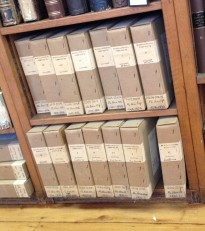 The location in Pusey House was beautiful as you would expect of Oxford, although smaller than I expected. Our conference room was surrounded by shelves; many of which held boxes which read “miscellaneous pamphlets” – made me feel very at home! Other elements were similar too – there was a confusing door entry system to rival my own in Newcastle and made me realise how offputting and confusing this must be to outsiders.
The location in Pusey House was beautiful as you would expect of Oxford, although smaller than I expected. Our conference room was surrounded by shelves; many of which held boxes which read “miscellaneous pamphlets” – made me feel very at home! Other elements were similar too – there was a confusing door entry system to rival my own in Newcastle and made me realise how offputting and confusing this must be to outsiders.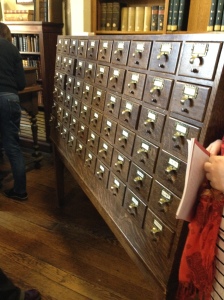 (Well, apart from a small selection of titles which have now been added to the main computerised Oxford LMS.)
(Well, apart from a small selection of titles which have now been added to the main computerised Oxford LMS.)
